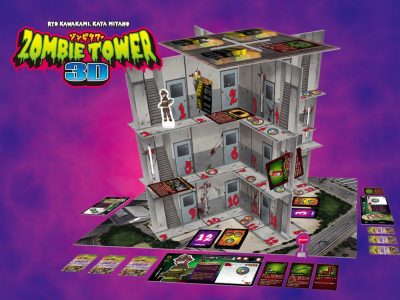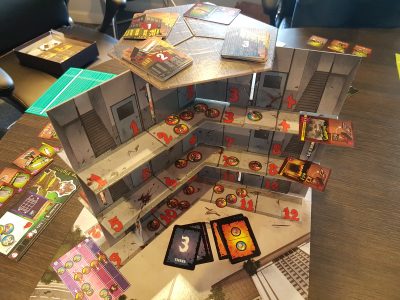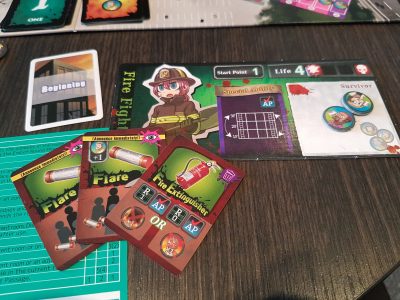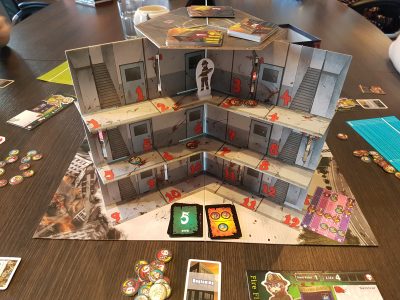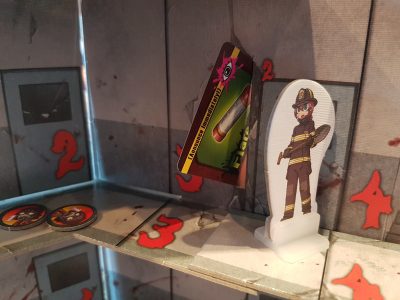Zombie Tower 3D is a semi-cooperative board game where players must work together to escape the tower they are trapped in. There are two ways to escape by helicopter or via a secret tunnel and which the players choose will largely depend on what loot they acquire as they often run from the zombies. Does the game offer something new for zombie fans to enjoy or will they be left wanting to escape the game? Let’s find out!
There are a lot of zombie board games out there but Zombie Tower 3D does plenty to break the “same old” recycled concepts hurdle many fall flat at. In a similar way to Colt Express, the game board being three-dimensional draws players into a rather unique experience. The design is even drilled into the mechanics of the game. So much so that the board couldn’t be on a flat board because players are only allowed to see one part of the tower, the part facing them. No peaking is allowed! This makes for an interesting situation where players cannot tell how well the zombie slaying is going for other survivors. Are your fellow heroes swiftly dispatching zombies or are they being overrun?
By default Zombie Tower 3D designed to be a semi-cooperative experience. This means that while everyone must survive for the game to be won, there is a winner at the end. Each player will have individual and secret objectives to gain points at the end of the game and saved survivors will also net players points. Passing a loot item through the walls of the tower to another player whom says they need it to survive may just be trying to hinder your point scoring ability rather than to survive. The potential of backstabbing therefore means players will soon start to wonder whom to trust and when to help.
I’m split on one decision we made when reviewing the game, as it improved the flow of the game yet it also removed some of the game’s personality. I found after switching to play Zombie Tower 3D as a completely co-operative game players’ enjoyment increased. Other games that aim to be semi co-operative are great at what they do, for example Bloodborne The Card Game. It is just Zombie Tower 3D seemed to flow better when players were being fully co-operative. Perhaps we just sucked at the game and needed to work together to survive at all.
The game is relatively straight forward to pick up and play. Players take it in turns to spend 3 action points (AP), before zombies try to consumer them and the other survivors. On a player’s turn they have a range of actions they can perform, some costing 1AP and others which are free. For 1AP players can move to one adjacent room, search for loot, rest to regain health or use an item. For free players may save a survivor, release saved survivors or pass items through selected areas of the towers walls. Players can also use Overcharge whenever they wish, taking 1 damage for an extra action point. This is a god send at times when a gang of zombies are only a room away.
Searching is one of the actions which sounds extremely helpful to your cause but can often be detrimental. It is unlikely from the number of times we have played Zombie Tower 3D but we might have just been getting extremely unlucky. It seems like no matter how much we shuffled the Search cards, fires and collapsing rooms occurred long before helpful items were discovered. Each player getting a starting piece of equipment was helpful but it did little to reduce the oncoming hordes of zombies. If for an action point survivors could take out a single zombie, the game would flow better in the beginning rounds. Even if survivors had to take one damage for doing so.
My biggest issue with the Search cards is not the probability of punishment, instead their placement. The core part of the tower is relatively solid but it is occasionally knocked accidentally by players when moving player character standees or the many zombie tokens. When you nudge the tower you get an almost Jenga feeling, of not wanting to knock the tower down, as the Search cards are by default placed on top of the tower. While we didn’t have cards spilling off the top, the worry that it might occur is enough to detract from the game experience. We ended up simply moving these card piles down to the ground board to get around this but I’m surprised this wasn’t picked up from playtesting.
There is often a trade-off between price and the inclusion of miniatures when zombies are involved. Zombicide utilizes full miniatures to great effect and Dead of Winter uses a lot of standees. Neither of these options would realistically work for Zombie Tower 3D as there is limited space on each floor section. In this game player characters are standees and for the many zombies, and survivors, tokens are used. Utilizing tokens is a great design element and the fact they are double sided tokens steps things up to the next level. On one side of the 1 tokens designates a Zombie and the other side designates 1 Survivor. For when hordes appear in the tower the 3 Zombie token can be flipped to represent 6 zombies. This helps keep the zombie count clear and the board not, literally, overflowing with the undead!
The theming presents a game that doesn’t try to take itself as seriously as other zombie board games, leaning more towards a cartoony atmosphere. Forget a light experience though, Zombie Tower 3D can become rather stressful, as every single action counts. Complexity wise new players should pick the games many mechanics up after a couple of turns. At a similar time into the game players will start to realise the extent of what a bad situation the survivors are in.
The game time does slightly increase when you move from 3 to 4 players. Thankfully the game’s design means that both the increase in game length and downtime between player interactions are kept to a minimum. The best example of this is the Emergence stage. It is completed at the start of every round by all players, independent of whom is going first. Everyone gets involved at once flipping one card to unveil where zombies spawn and another to see where a survivor spawns.
Peculiarly downtime becomes an advantage. Passing from the first player of the round, as with many games, to the to the player whom goes last. The last player to go that round has more time to plan how best to spend their limited action points. With less downtime before their turn, after finding out where the new survivor and zombies have emerged, and it is more likely players are to make a rushed decision. Zombies may be trying to eat you but rushing is never a good plan.
While the core of the tower is sturdy when built, it is a tad fiddly to construct. The issue is this extends the set-up time and must be done each time you take the game out of the box. Conversely, you could say it allows the game to pack away into a much smaller box. Thus, not wasting room on your gaming shelf! Aside from the core of the tower the floors have additional floor parts which slide into grooves and rest on the core section. Overall, this does the job but players have to be careful. Small plastic clips would have been a great inclusion in the box as they could be used to make the whole 3D board that bit more ridged.
After the first few games, with one of them surprisingly being successful, I was left expecting more from the game. It felt as if it was a step away from being a solid game, fit for my gaming shelf. Switching to the fully cooperative rules certainly bumped up Zombie Tower 3D to be more than just a “playable” game. The mechanics of survivors and zombies spawning via cards isn’t new but where they spawn being based on the previously flipped card certainly is. This alongside the passing of items through the walls of the 3D tower creates a game that has a lot of attraction. Zombie Tower 3D won’t be hitting my gaming table overly often but when it does it offers players a rather unique gaming experience. For a board game, let alone about zombies, that is hard to manage and that will undoubtedly be the games selling point to many whom play it.
[Editor’s Note: Zombie Tower 3D was provided to us by Cosaic for review purposes.]


